EAR TAG CUSTOMIZATION
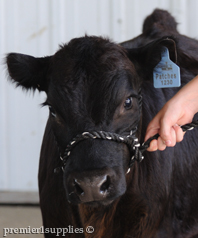
Premier can even do a custom logo on all tag sizes. The tag shown is a Z Tag One-Piece Calf tag.
We specialize in custom imprinting!
Premier can custom laser imprint (personalize) your tags for a low price before they leave our door. Will ship to you within 2 business days of receiving your order.
How to order:
| 1. |
Select tags. |
| 2. |
Determine imprint.
| • |
Numbers (must be consecutive)—with or without repeating farm/ranch names. |
| • |
Logos/Brands—a one-time $15 setup fee per design. |
| • |
Individual names or numbers—$2 per tag. |
|
| 3. |
Imprint location—male side, female side or both. |
TAG PLACEMENT
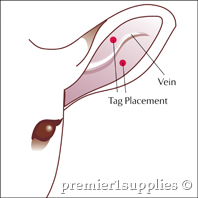 Tag placement is critical to success!
Tag placement is critical to success!
For maximum retention and the lowest risk of bleeding and infection, place ear tags in either of the two spots.
The opposite extreme (installing too far from the skull) will result in more lost tags as the tissue on the tip of the ear is tender and tears easily.
Be careful to avoid the large vein (shown above).
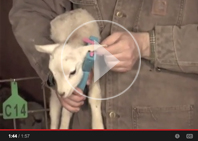
Click here to watch our video on how-to install ear tags with an applicator.
PERMANENT IDENTIFICATION
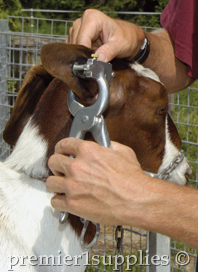 Tattooers—easily and permanently identify your animals.
Tattooers—easily and permanently identify your animals.
How-to tattoo
| 1. |
Apply ink to intended tattoo site. Use latex gloves, it's messy. |
| 2. |
Insert letters/digits into tattooer; firmly apply to inked site.
|
| 3. |
Rub new or existing ink into newly applied tattoo. male side, female side or both. |
| 4. |
If done correctly, tattoo can be read for animal's entire life. |
Available tattooers:
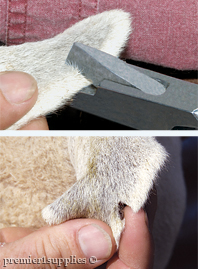 Ear Notcher
Ear Notcher
For marking culls on the spot, just notch an animal's ear (or its tag) for each “problem.” Provides very permanent identification. Will outlast you!
LIVESTOCK TREATMENTS
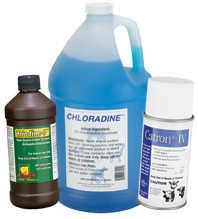 Triodine-7
Triodine-7
A very effective management product that quickly sanitizes and dries navel cords on newborns which drastically reduces the risk of infection via the navel. Those that have used iodine in the past will appreciate the arrival of an equivalent alternative.
Chloradine™
2% Chlorhexidine Gluconate. Wash animal surface area with cleaning solution and wipe dry. Do not leave product in direct sunlight. Close container after use. Use 1 oz. of Chloradine per 1 gallon of water.
Catron® IV
The best product for treating sheep with flystrike. One can will treat from 1 - 10 animals depending on severity of fly-strike.
|
 |
 |
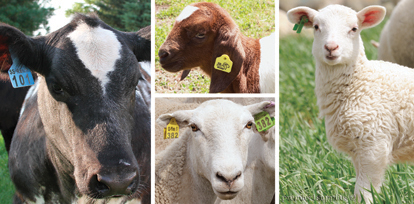
Identification is useful for all ages of livestock and goes a long way to making producers' lives easier.
Happy New Year, folks!
The year for us is off to a fantastic start. We're 2 weeks into our lambing season and our lambing barn is already bursting at the seams with new lambs (or so it seems).
Premier's farm guys are busy processing newborn lambs, which includes docking, castrating and ear tagging. We go through a significant number of ear tags during the lambing season. Some tags are for testing purposes (this is how Premier determines the best tags to offer), and others are for ID. Each lamb receives a tag, and ewe lambs born as twins, triplets or quads are ear-notched to indicate their prolific potential.
For more information on tagging and identification, Michael Neary, Extension Specialist from Purdue University, has provided an article on different methods of ID. We've also included a few details about ear tagging procedures and uses that Premier has found useful.
EXTENSION NEWS
Methods of Livestock Identification
By Michael Neary, Extension Animal Scientist, and Ann Yager, Animal Sciences Student, Purdue University
Animal identification is the basis for keeping accurate production records of the herd/flock. Individual animal identification allows producers to keep records on an animal's parentage, birth date, production records, health history, and a host of other important management information. Accurate records provide the producer with enough information to make individual or whole herd/flock management decisions. In many instances, the producer needs to be able to quickly identify an animal. A successful identification system makes this task more efficient. Identification is also important to indicate ownership of a particular animal, or to indicate the herd/flock of origin.
There are many identification systems, but selection should be based on the method that best fits an operation's needs. Factors such as size of the operation, type of records kept, and source of replacement breeding stock, determines which system(s) to choose. When selecting forms of identification, consider the application methods for each type, along with visibility from a distance, equipment needed for application, cost, permanence, and how easy or difficult the method is to apply. Two different methods should be used to assure permanent identification. Once a system has been selected, it is important to be consistent with providing each animal a unique and permanent identification number that matches with each method used. Be careful not to duplicate numbers over a minimum of a ten-year period.
When an animal is born/purchased, it should be identified immediately with only one unique number, which will serve as its identification number until it departs from the herd/flock.
Numbering Systems
There are many numbering systems that can be used to identify animals in a herd. One of the most commonly used and highly recommended systems uses a combination of letters and numbers, designating birth year and birth order, respectively.
Read More »
PREMIER TIPS
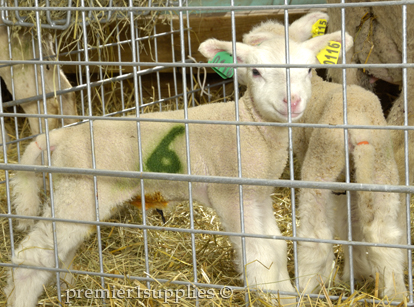
Twin lambs in a lambing jug. Note the use of 2 ear tags and Sprayline for the use of identification.
Ear Tag FAQs & Tips
How can I reduce tag losses?
| • |
Insert tag midway between the skull and the tip of the ear. Tags placed too close to the skull in sheep are more likely to become infected. Why? 1) The tissue can become too thick for the tag; and 2) the wound is less able to heal (not enough air). |
| • |
Avoid the larger veins in the ear. Why? Tissue around damaged veins heals less rapidly and is more prone to infection. |
| • |
Don’t use cheaper nylon (e.g. Snapp or Swivel) tags as long-term tags. Why? They quickly become brittle from UV light. |
| • |
Avoid double-button round tags for sheep and goats. Why? They are more likely to snag and tear on long grass, vines, wire fences and hay feeders. |
| • |
Avoid low-fiber diets. Why? Sheep on high-grain or liquid diets are desperate to chew—even on ear tags. When one starts chewing tags, its pen-mates will copy the behavior. |
How do I keep track of an animal if
a tag falls out?
| 1. |
Install 2 tags (one in each ear)—with the same number. Official tags can’t be duplicated—but you can use the same individual animal number on the second “backup” tag if you don’t add a flock or premise number. |
| 2. |
Tattoo the animal. No animal ID is more permanent.
|
What tag system do we use?
We are always experimenting. So we use many tags. Currently Premier’s preferred system is to:
| 1. |
Tag baby lambs with two size Q-flex 1.0 tags (same numbers for each tag) within 4 weeks of lambing. We select tag color, numbers, placement to indicate twin-single-triplet/year of birth/sex. |
| 2. |
For breeding sheep we substitute a Q-flex 5 tag for the size 1.0 tag (much easier to see) in the same hole!
|
| 3. |
We never install official tags until the animal is ready to leave the farm.
|
How long does it take to get ear tags from Premier?
Usually less than 2 business days to print and ship them. Then it’s up to FedEx, UPS or USPS mail to get it to you. We can expedite the shipment—but faster shipping methods will cost you more $$.
What tag colors imprint the best—and the worst?
As a rule:
| • |
Light colors (spearmint, salmon, yellow, white) are the most readable. |
| • |
Dark colors (brown, purple, red) are the least readable. |
How Ear Tags Can Help You…
1. To indicate sex
Benefits:
| 1. |
Allows rapid sorting by sex while sheep and goats are moving down a chute or in a holding pen. |
| 2. |
No need to get your hands dirty or spend valuable time to “check the plumbing” of each animal.
|
To do this:
| • |
Ears of males: Insert primary tag in left ear. |
| • |
Ears of females: Insert primary tag in right ear. |
|
2. To indicate year of birth
Benefit: No need to catch them to check teeth. A tag will tell you the age from 25 ft away. Faster decisions when sorting for culling or breeding.
Two ways to do this (we do both):
| 1. |
Use a different color for each year. Lambs with purple tags were born in 2010. Lamb with yellow tag in year 2011. |
| 2. |
Begin tag number series with the year of birth. Tag 147275 indicates lamb is the 275th lamb tagged in 2014.
|
|
3. To indicate sire (and dam)
Benefits: No need to check records for breeding decisions.
Three ways to do this:
| 1. |
Use a different color second tag for each sire (blue tags = Sire XYZ; purple tags = Sire ABC). |
| 2. |
Have sire name printed on the tag of its progeny.
|
| 3. |
Hand-write the ewe’s tag number with a marking pen on the lamb’s tag. If space is limited write it on the inner surfaces of the tag.
|
|
Note: Since tags can be lost, we strongly advise using 2 sire/dam tags (one in each ear).
4. To indicate single, twin or triplet
Benefits: Speeds up sorting for breeding and sale purposes. Reduces need to keep and/or consult records.
To do this:
Use a different color for each lamb type. Repeat this color year after year.
Premier’s code is:
| • |
blue = single |
| • |
green = twin |
| • |
orange = triplet |
So if lamb is a twin—green tag. If lamb is a single—blue tag.
|
5. To indicate problems
Benefits: Allows rapid, positive culling of animals with foot problems, dystocia, mastitis, prolapse, etc.
Two ways to do this:
| 1. |
Place a black tag into every problem animal. |
| 2. |
Use an ear notcher to mark the animal.
|
|
EAR TAG SAFETY
Infections From Tagging Sheep—Causes, Factors & Solutions
The risk—how serious is it?
Can be very serious. If not “caught” quickly, it can disfigure a sheep for life or may force them to be culled early.
How often does it occur?
Seldom in the dry areas of the West and Southwest. Too often in humid areas.
Have we had tags cause infection here at Premier?
Mild infection/reaction in the week after tagging is more common than most think. You have to look closely to see it. It usually heals on its own.
Serious infections have occurred twice:
| 1. |
In 2003 after inserting 5 brands of RFID tags in adult sheep in July. |
| 2. |
In 2008 during a side-by-side trial with 2 different tags inserted in 400 adults and lambs in a humid May and June. Lambs were minimally affected but adults were badly affected. Both groups were on grass.
|
Common factors: Adult sheep and Iowa’s summer heat and humidity.
Does the brand of tag matter?
Not if the tag design is similar. At a major sheep show we observed mild infection with most brands.
Does the tag type (metal vs round vs leaf/flag-shaped) make a difference?
All other things being equal (but they rarely are), designs that allow more air near the wound will show less infection.
How can I reduce the risk of infected
ears from tagging?
1. Tag them as lambs or kids.
If you do this, most of the other items on this list can be ignored. Why? Because young ear tissue is less likely to be covered with “nasty” micro-organisms waiting for a fresh wound to provide an opportunity.
We’ve observed that:
| • |
Serious infections in properly tagged young lambs are rare. |
| • |
The older the animal, the more likely it is that serious infection will occur from ear tagging. |
A huge advantage of tagging a young lamb is that, when it’s an adult, it’s a simple, no-risk, no-stress task to cut out the temporary tag and insert a permanent tag into the pre-existing hole.
2. Don’t insert tags in “fly/gnat seasons”
(late spring and summer in the Midwest). Why? Fresh wounds from tagging attract flies and gnats. In response animals shake their heads—which irritates the tissue and delays healing. If you must tag during fly season, apply a fly repellent (Permethrin, Catron IV or Pine Tar) to the ear after tagging.
3. If you live in a humid climate, tag in the winter. Why?
| • |
The air is less humid so wounded tissue heals more readily. |
| • |
Because there are no flies to irritate the area. |
4. Don’t place tags close to the skull.
Ear tissue thickens as the animal ages, which further limits access to air. So the ear is more prone to infection—and therefore the tag may have to be removed.
5. Tag when the ear is dry and clean.
The more dirt (particularly if it includes manure) and the more moisture on the ear tissue at the time of tagging, the more likely it is that serious infection will occur.
6. Use small tags.
Why? To reduce weight on the ear and therefore the amount of tissue irritation. Smaller tags also allow more air access to the wound.
7. Avoid metal or round tags.
Both designs reduce air access. We bought a goat 6 years ago that had an official metal tag. It was moderately infected then. It’s still a little infected but it’s illegal to remove it.
8. Apply an antibiotic, a fly repellent or a disinfectant to the ear tissue or tag.
For drying up wounded skin tissue, nothing works quicker than Triodine-7 (which is why it’s used to treat newborn lamb navels), but it stains the tag and the ear. So Chloradine and Catron IV are probably the best choices for small flocks/herds.
|
|